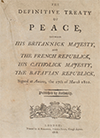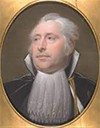The Batavian Revolution and Republic
Part 2: The Republic As the victorious and occupying army, France set the terms of engagement between the French revolutionary government and the Batavian Republic; as a result of an unequal treaty in May 1795, the latter was very much a client state of the former. The new republic had a new state entity, the Provisional Representatives of the People of Holland, succeeding the abolished States of Holland and West Friesland. The cities making up the devolved states gained the privilege of sending members to the States-General, which continued to be nominally in charge of the government. That representative body lasted nearly a year in power before a groundswell of revolutionary fervor convinced leaders to adopt a new governing body, the National Assembly. Still in search of a constitution, a number of influential leaders drafted one, which the Assembly approved in May 1797 but which the people at large defeated in a referendum three months later. A coup in early 1798 brought into power the members of the National Assembly who most wanted representative government. Their legislative efforts resulted in a referendum-approved constitution that, among other things, guaranteed universal male suffrage. Such radical actions resulted in a counter uprising, another coup, and a new National Assembly, renamed the Executive Authority. Effectively the head of state was the Staatsbewind (State Council), with the president of that body serving as the nominal head of state. Looking to break some power while consolidating others, the new government divided the mighty province of Holland into three (Amstel, Delf, and Texel) and melded a handful of smaller provinces into newly created ones. The following year, Dutch forces turned back a joint invasion by British and Russian troops, ending the threat in October 1799 at The Treaty of Amiens resulted in peace, for a time. But war returned and with it uncertainty in the highest levels of Dutch government. By now unquestionably the powerhouse in Europe, France, in the form of Emperor Napoleon Bonaparte, brought about yet He did have the equivalent of a Cabinet. His Secretary for the Navy, Carel Hendrik Ver Huell, positioned himself at the head of a movement to oust Schimmelpenninck, who suffered increasingly from physical problems. Meanwhile, France was gaining more and First page > The Revolution > Page 1, 2 |
|
Social Studies for Kids
copyright 2002–2025
David White



 Castricum. Whatever breathing room the Dutch received dissipated after yet another coup, in 1801. In that same year began negotiations that resulted, in the following year, in the wide-ranging Treaty of Amiens. Historians generally refer to this international agreement as a plea of peace between France and Great Britain, and it was, but the Batavian Republic also benefited from this treaty in that, as a party to the treaty, the republic gained international recognition. More importantly in economic terms, the Dutch regained most colonies lost to British forces in the last war.
Castricum. Whatever breathing room the Dutch received dissipated after yet another coup, in 1801. In that same year began negotiations that resulted, in the following year, in the wide-ranging Treaty of Amiens. Historians generally refer to this international agreement as a plea of peace between France and Great Britain, and it was, but the Batavian Republic also benefited from this treaty in that, as a party to the treaty, the republic gained international recognition. More importantly in economic terms, the Dutch regained most colonies lost to British forces in the last war. another new constitution and government for the Batavian Republic. The new man in charge was Rutger Jan Schimmelpenninck (right), who had been the republic's ambassador to France. Taking on the mantle of Raadpensionaris (Grand Pensionary), Schimmelpenninck, beginning in 1805, functioned as a one-man executive branch, outranking the newly created Legislative Corps.
another new constitution and government for the Batavian Republic. The new man in charge was Rutger Jan Schimmelpenninck (right), who had been the republic's ambassador to France. Taking on the mantle of Raadpensionaris (Grand Pensionary), Schimmelpenninck, beginning in 1805, functioned as a one-man executive branch, outranking the newly created Legislative Corps. more success on the battlefields of Europe, resulting in more and more client kingdoms. Bonaparte eventually decided that his brother Louis was needed to run the Dutch government. Schimmelpenninck resigned in June 1806, and the Kingdom of Holland, with
more success on the battlefields of Europe, resulting in more and more client kingdoms. Bonaparte eventually decided that his brother Louis was needed to run the Dutch government. Schimmelpenninck resigned in June 1806, and the Kingdom of Holland, with 
